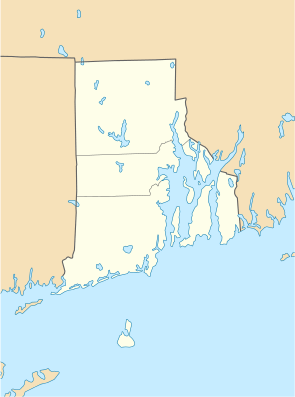Hunter House (Newport, Rhode Island)
|
Hunter House | |
|
U.S. National Historic Landmark District Contributing Property | |
 | |
|
Front elevation of house in 2008 | |
 | |
| Location | Newport, RI |
|---|---|
| Coordinates | 41°29′33.19″N 71°19′18.14″W / 41.4925528°N 71.3217056°WCoordinates: 41°29′33.19″N 71°19′18.14″W / 41.4925528°N 71.3217056°W |
| Built | 1748 |
| Architectural style | Georgian |
| Governing body | Private |
| Part of | Newport Historic District (#68000001) |
| NRHP Reference # | 68000003 |
| Significant dates | |
| Added to NRHP | November 24, 1968[1] |
| Designated NHL | November 24, 1968[2] |
| Designated NHLDCP | November 24, 1968 |
Hunter House (1748) is a historic house in Newport, Rhode Island. It is located at 54 Washington Street in the Easton's Point neighborhood, near the northern end of the Newport Historic District.
History
The original portion of Hunter House was built in 1748 for Colonial Deputy Governor Jonathan Nichols, Jr. The architecture of Hunter House is currently Georgian Colonial. This large 2½-story house has a balustraded gambrel roof and heavy stud construction. In 1756, the property was sold to Colonel Joseph Wanton, Jr., who was a deputy governor of the colony and a merchant. Wanton enlarged the house by adding a south wing and a second chimney, transforming the building into a formal Georgian mansion with a large central hall. During the American Revolution, Wanton remained a Loyalist, and General William West ordered Wanton imprisoned in Providence and tried by the legislature. Eventually, Wanton fled Newport when the British left the city. After Wanton fled, the house was used as the headquarters of Admiral de Ternay, commander of the French fleet, when French forces occupied Newport in 1780. After the war, William Hunter, a U.S. Senator and ambassador, bought Wanton's house and transformed it into a formal Georgian mansion with a large central hall.
The house was purchased in 1945 to prevent its demolition, leading to the formation of the Preservation Society of Newport County. Hunter House was designated a National Historic Landmark on November 24, 1968. It is currently open for limited public tours, and displays period furnishings by Townsend and Goddard; paintings, including one by Gilbert Stuart; and a restored 18th-century garden.
It is also known for its woodwork, including a carved pineapple over the doorway, a symbol of welcome throughout Colonial America. During the restoration, Newport-made cabinetry from as far away as Scotland was brought back and installed in the house. "Today the visitor to Hunter House comes under the spell of a spectacular interior," says Ralph Carpenter, who supervised the furniture restoration, "with floor-to-ceiling paneling framed with bolection moldings, intricately twisted balusters on the stairs, eighteenth-century Delft tiles around many of the fireplaces, pilasters with Corinthian capitals, and marbleizing and grain painting throughout."[3]
-

Hunter House from the water side
See also
| Wikimedia Commons has media related to Hunter House (Newport, Rhode Island). |
- List of National Historic Landmarks in Rhode Island
- National Register of Historic Places listings in Newport County, Rhode Island
References
- ↑ "National Register Information System". National Register of Historic Places. National Park Service. 2007-01-23.
- ↑ "Hunter House". National Historic Landmark summary listing. National Park Service. Retrieved 2008-06-28.
- ↑ Carpenter, Ralph (April 1995). "Newport, a center of colonial cabinetmaking". Magazine Antiques. Retrieved 2008-04-25.
External links
| ||||||||||||||||||||||||||